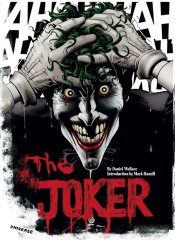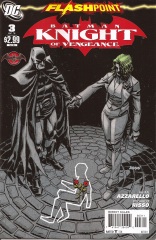This is a reprint from an article by JOHN SAAVEDRA titled “SCOTT SNYDER AND GREG CAPULLO’S JOKER: A HAUNTING IN GOTHAM CITY” that appeared in the site DEN OF GEEK.
I found it interesting and very comprehensive, and now that I am following the new Joker storyline of ENDGAME (which for those who need to know, started in BATMAN ##35) I have to agree that the new twist on the Joker’s little revenge plans are hinting a little towards the supernatural. Don’t know exactly where Snyder and Capullo are heading for, but I have complete trust on his writer’s abilities (Snyder had demonstrated them more than once with COURT OF OWLS and DEATH OF THE FAMILY among other storylines). I believe that the supernatural can be fun too if it is written well and with respect for the characters own history (remember, there has been Joker and Batman for almost 75 years now and just because the Batman comics restarted the saga, does not mean that the past is completely gone. Even Snyder had paid homage to the Joker’s past in his DEATH OF THE FAMILY run).
I think we are all in for a surprise, and Snyder himself has said in multitude of interviews that this story will change EVERYTHING in the Batman world. Let’s hope it will be worth the wait and news buzz.
Well since no more interruption…here is the transcript of the article. WARNING: SPOILERS AHEAD…READ AT YOUR OWN RISK!
The Joker is back in Batman: Endgame, but he’s not the same old clown. He’s something more. Snyder and Capullo turned him into a haunting.
Editor’s Note: This article contains Batman comics spoilers…
When I spoke to the Batman team of Scott Snyder and Greg Capullo at NYCC 2014, something Capullo, who drew his share of monsters with Spawn, said really stuck with me: “What kid or adult doesn’t love a monster?” We were specifically talking about the Joker, who made his triumphant return to the pages of Batman back in October, after an almost two year absence. Of course, it was revealed in Batman #36 that he’s been creeping his way from panel to panel all along, but we’ll get to that in a moment.
Snyder and Capullo’s Joker is a special kind of animal, the one closest to the form I always thought the villain should become — the omnipotent, indestructible evil that can commit any atrocity that enters its twisted mind. A creature much larger than the entire Batman legend that can transcend a physical form. It doesn’t even suffice to call the Joker a “he” anymore since it’s all but obvious in #37 that Batman is dealing with a beast. Whether the beast is the devil or just a demon (or perhaps its all a trick of the light) still remains to be seen. For now, we watch him smile through the flames:
In case you haven’t read that issue, which I suggest you do at all costs, the above panel shows Snyder and Capullo take their first big step into the supernatural within the pages of Batman. A few panels before, Gordon shot the Joker in the chest and the villain fell back into a fire. A relieved Commissioner Gordon calls Batman to tell him the good news. The city is still going to shit with the zombie-like apocalypse brought on by the new, invincible strain of the Joker’s laughing gas, but at least the Joker’s dead…I’m not sure I’ve seen anyone so absolutely finish off the Joker since his death in Batman: Arkham City or “death and rebirth” in Grant Morrison’s run a few years back. But Gordon learned quite a bit about the Joker this issue. He’d do well to turn around.
There are a couple of big discoveries made about this version of the Joker in Batman #37. In fact, I’d even even call it a primer for what this new era’s Joker is going to be/what he’s been about all along. Snyder brought his complete writing toolkit to the book in “Endgame,” the arc in which all of this takes place. While the writer has mostly kept the supernatural out of this run, he’s definitely a veteran of the form. American Vampire, The Wake, and now Wytches have all solidified Snyder’s place in the realm of scary supernatural tales. Finally, we see him bring that to Batman in full form, introducing the Lovecraftian tone that he’s so good at. Snyder’s Joker, it would seem, is the beast that’s older than time itself. At least older than Batman.
We get a clue of just how long the Joker has haunted Gotham City, a discovery made by poor Jim Gordon, who gets his fair share of trouble in this arc, and will probably see even more by the time Batman #40 rolls out in March. Without spoiling too much of the plot, Gordon is investigating the mysterious tragedies that have plagued Gotham’s oldest hospital, where Batman must go to find the source of the Joker’s new toxin. In each old newspaper clipping — some dating back to the early 1900s — Gordon finds a familiar face in the background:
Peek-a-boo. The name Gordon is about to utter, as the smoke and fire from his cigarette engulfs his computer screen, is “Beelzebub,” which is the name of the devil. That face belongs to none other than the Joker. If this picture is real, that means that the Joker of the New 52 has been in business for much longer than Batman, who’s only been fighting crime for about six years in current DC continuity. That’s disturbing.
What’s even more disturbing is what happens next. Playing out like the best ghost stories, a scene as good as Nosferatu climbing up a set of stairs or Stephen King’s Pennywise preying on little children from a gutter, the Joker is revealed as the monster under the bed:
You see why Gordon probably shouldn’t’ve turned his back on the Clown? Joker, the haunting of Gotham City has arrived. But Gordon can’t believe that the Joker could be more than just a mortal man, although I don’t know anybody who would bother calling the villain a human except perhaps Alan Moore, and neither can Bruce, whose quest throughout Snyder’s run has been pretty specific: figure out who the Joker is and stop him once and for all. You remember Bruce sitting in the Batcave at the end of “Death of the Family,” the Batcomputer coming up with zero results for the Joker’s identity. Only the word “Ha” flashes on the screen, a new element in Joker’s gas.
It’s no accident that Batman #37 opens with Bruce telling himself that Joker is nothing more than a man. All along, he’s been trying to put a face to the name, to bring the Clown down to size, to prove his biggest fear wrong. If Joker is nothing more than a mere man, he can be defeated. We see Batman easily defeat Joker in the opening pages of Detective Comics Vol. 2 #1. This is shortly before Joker has Dollmaker cut off his face, so that he may be reborn.
So much of Synder and Capullo’s run has focused on the Joker. From the Joker-centric “Death of the Family,” which Snyder likes to call a comedy — in the dramatic sense, of course — to “Zero Year,” which calls back to the classic “Red Hood” Joker origin story of the Silver Age, not to mention Alan Moore and Brian Bolland’s The Killing Joke, the team have chronicled the Joker’s transformation. And in “Endgame,” this tragedy about Batman’s mortality (Snyder’s words, not mine), the stage is set for Joker’s transcendence.
It’s appropriate then that the Joker’s sinister smile and mad laugh would be pasted on the faces of every Gothamite and heard in even the darkest alleys of the city during the villain’s latest attack. The idea that the Joker is more of a force than just a criminal mastermind has never been more apparent. He can be anyone and everywhere. It’s not hard to believe that he could take on the face of Arkham Asylum’s Eric Border in order to keep an eye on Batman, to continue their mad dance:
In Batman #36, we get a pretty satisfying answer as to how Joker was able to maintain his Eric Border disguise since his introduction in Batman Annual #2, only a couple of months after the Joker’s demise at the end of “Death of the Family.” Not much in terms of the supernatural going on there. He took some pills that allowed him to keep the psychotic smile off of his face for a couple of hours at a time. Simple and believable, as far as realism in comics goes.
But even this serves Snyder and Capullo’s purposes. The idea that the Joker can be a cunning master of disguise and deception, that he can become Batman’s most trusted ally within Arkham Asylum while pulling the strings behind the scenes, it all serves as further evidence that Joker could be Snyder’s version of the devil in the pages of Batman, the lord of temptation that whispers in Bruce’s ear. Join me. Join me. You helped me evolve. Now let me help you…
It all comes down to evolution on the Joker’s part. The Batman team has made it so that, even if the Joker is faking his supernatural state, we can sure believe that the Joker could transform into this invincible demonic being. For one thing, Joker tried to help Batman evolve along with him earlier in the run. Snyder has talked at length about how his Joker wanted to help Batman transcend and reach his true potential in “Death of the Family.” Joker asked Bruce to leave his silly little family behind and become more than this mortal man who would one day finally wear out. Make no mistake about it: no matter how twisted the Joker can be, he’s never been interested in killing off the Batman. But rather, to help him live on forever, so that they can continue their hellish love affair for all eternity. In Snyder and Capullo’s Batman, it’s true what we’ve all suspected all along: one can’t live without the other. Until now.
After Batman rejects the Joker’s offer to be greater, to be more than a mere human, the Joker decides to break all ties. There’s a change in the dynamic. The Joker doesn’t need the Batman anymore. The monster has evolved past the hero. If this supernatural form is the final step of the transformation for the Joker, then Bruce and his family are definitely in trouble.
In an interview with CBR about Batman #35, Snyder described Joker’s throught process, as he begins his final battle with Batman: “Joker’s saying, ‘This is the end of us. This is it. This is the last Joker story of Batman and Joker.’ Joker is moving on, is what Joker would say. So it’s really the end of the game played between the two of them.”
How Joker survived the events of “Death of the Family” without a face is anyone’s guess. Snyder hasn’t explained what happened between that arc and Eric Border’s first appearance a few months later, but I’m guessing it all has ties to the supernatural. By the time Joker has his face cut off and jumps off a cliff to a watery doom at the end of his twisted comedy, the final transformation has been triggered. The Joker From Hell.
At NYCC, Snyder and Capullo told me that in “Endgame,” the Joker was out to really hurt Bruce, who must confront his own mortality and his choice to remain tethered to the family that keeps him human. The Joker is pissed about Bruce’s decision and decides to end the man himself. Snyder said, “This time, [Joker]’s going to be looking for a kind of tragedy.” You can see it in Joker’s face:
“Endgame” has been the subject of feverish discussion for Batfans. Some thought perhaps it meant that it would be the end of Snyder and Capullo’s run on the book. I know, ridiculous. But it definitely is an end of sorts to their fantastic run thus far. It is the final act of a three-part Joker arc that has been masterfully woven by Snyder and brought to life by Capullo’s pencils. While Snyder has said that he doesn’t plan to use Joker in his run again, he won’t completely rule it out if there’s another story to tell.
Come June, after DC’s two-month Convergence event, Snyder and Capullo will return with what he’s referred to as soft relaunch of the book. It will be an all-new Batman with plenty of great, gutsy, new stories to tell. I wouldn’t be surprised if the Clown Prince From Hell is creeping behind some of those panels, waiting to be born again…
John Saavedra is currently working on a Master’s thesis about Scott Snyder’s work. What a time to be alive.
(Original article appeared in January 7, 2015 at DEN OF GEEK HERE)







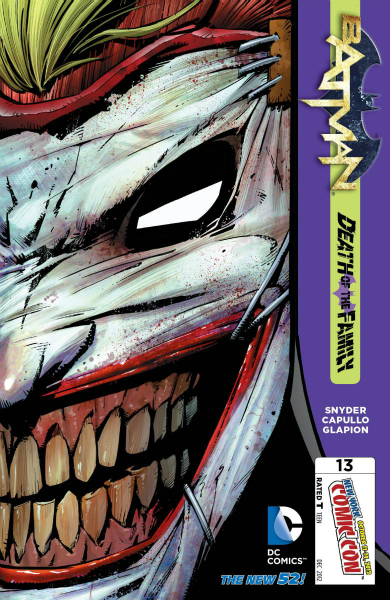 It was past midnight and could not help myself. Even when I have a few copies of BATMAN #13 reserved and waiting for me at home in Fla. I had to read it so I bought a digital copy and
It was past midnight and could not help myself. Even when I have a few copies of BATMAN #13 reserved and waiting for me at home in Fla. I had to read it so I bought a digital copy and 



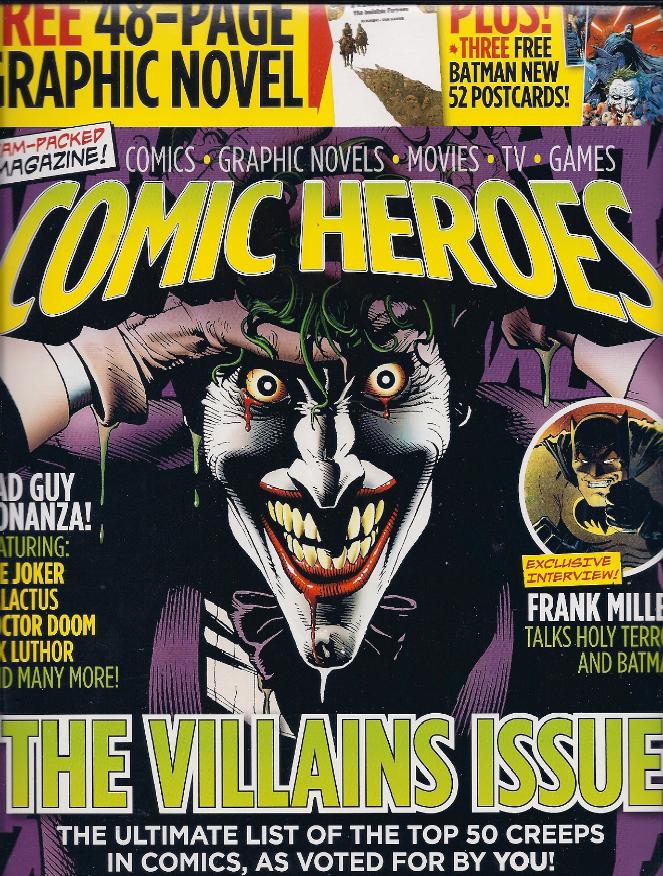
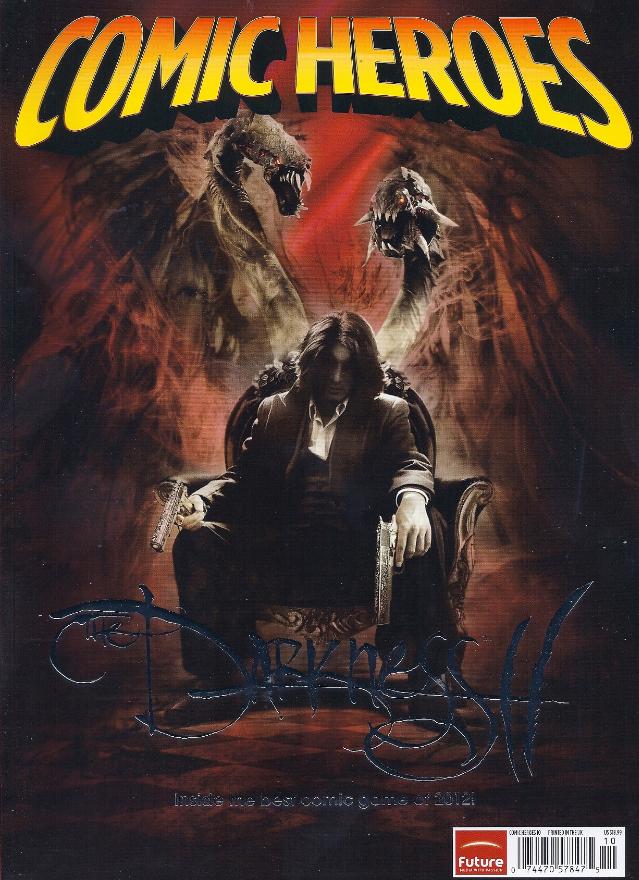



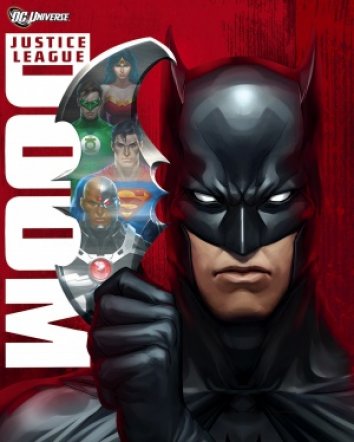 I never know what to expect these days when I sit down to watch the latest animated feature from Warner Home Video. They’ve had a few titles that blew me away (Wonder Woman) and a few that disappointed (Green Lantern: First Flight), so expectations were high as I settled in for the premiere of Justice League: Doom. A great writer, great cast, and one of my favorite comic stories being adapted made me hopeful this would be a good one.
I never know what to expect these days when I sit down to watch the latest animated feature from Warner Home Video. They’ve had a few titles that blew me away (Wonder Woman) and a few that disappointed (Green Lantern: First Flight), so expectations were high as I settled in for the premiere of Justice League: Doom. A great writer, great cast, and one of my favorite comic stories being adapted made me hopeful this would be a good one.







